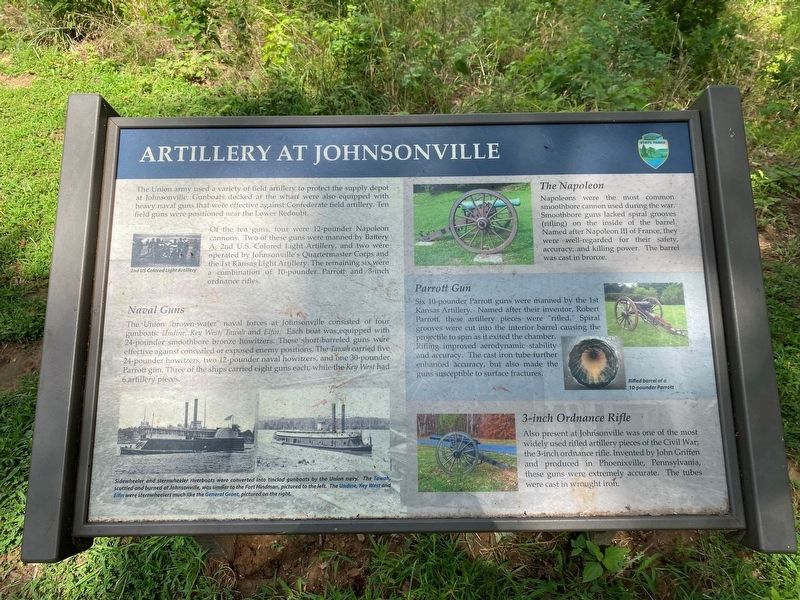Artillery at Johnsonville
Of the ten guns, four were 12-pounder Napoleon cannons. Two of these guns were manned by Battery A, 2nd U.S. Colored Light Artillery, and two węre-operated by Johnsonville's Quartermaster Corps and the 1st Kansas Light Artillery. The remaining six were a combination of 10-pounder Parrott and 3-inch ordnance rifles.
Naval Guns
The Union "brown-water” naval forces at Johnsonville consisted of four gunboats: Undine, Key West, Tawah and Elfin/ Each boat was equipped with 24-pounder smoothbore bronze howitzers. These short-barreled guns were effective against concealed or exposed enemy positions. The Tawah carried five 24-pounder howitzers, two 12-pounder naval howitzers, and one 30-pounder Parrott gun. Three of the ships carried eight guns each, while the Key West had 6 artillery pieces.
The Napoleon
Napoleons were the most common smoothbore cannon used during the war. Smoothbore guns lacked spiral grooves (rifling) on the inside of the barrel. Named after Napoleon III of France, they were well-regarded
Parrott Gun
Six 10-pounder Parrott guns were manned by the 1st Kansas Artillery. Named after their inventor, Robert Parrott, these artillery pieces were "rifled.” Spiral grooves were cut into the interior barrel causing the projectile to spin as it exited the chamber. Rifling improved aerodynamic stability and accuracy. The cast iron tube further enhanced accuracy, but also made the guns susceptible to surface fractures.
3-inch Ordnance Rifle
Also present at Johnsonville was one of the most widely used rifled artillery pieces of the Civil War; the 3-inch ordnance rifle. Invented by John Griffen and produced in Phoenixville, Pennsylvania, these guns were extremely accurate. The tubes were cast in wrought iron.
(Photo captions)
2nd U.S. Colored Light Artillery
Sidewheeler and sternwheeler riverboats were converted into tinclad gunboats by the Union navy. The Tawah, scuttled and burned at Johnsonville, was similar to the Fort Hindman, pictured to the left. The Undine, Key West and Elfin were sternwheelers much like the General Grant, pictured on the right.
Rifled barrel of a 10-pounder Parrott
Erected by Tennessee State Parks.
Topics. This historical
Location. 36° 3.79′ N, 87° 57.987′ W. Marker is in New Johnsonville, Tennessee, in Humphreys County. Marker can be reached from Old Johnsonville Road west of Museum Road, on the right when traveling west. Located in Johnsonville State Historic Park. Touch for map. Marker is in this post office area: New Johnsonville TN 37134, United States of America. Touch for directions.
Other nearby markers. At least 8 other markers are within walking distance of this marker. The Union Supply Depot (within shouting distance of this marker); The Tennessee River in the Civil War (within shouting distance of this marker); Forrest Shells the Depot (within shouting distance of this marker); Forrest's Opening Move (about 300 feet away, measured in a direct line); The Final Tally (about 300 feet away); The Horse Corral (about 300 feet away); Winfrey Cemetery (about 500 feet away); Lower Redoubt (about 500 feet away). Touch for a list and map of all markers in New Johnsonville.
Also see . . . Johnsonville State Historic Park. (Submitted on July 16, 2021.)
Credits. This page was last revised on July 16, 2021. It was originally submitted on July 15, 2021, by Darren Jefferson Clay of Duluth, Georgia. This page has been viewed 157 times since then and 15 times this year. Last updated on July 16, 2021, by Darren Jefferson Clay of Duluth, Georgia. Photos: 1. submitted on July 15, 2021, by Darren Jefferson Clay of Duluth, Georgia. 2. submitted on July 16, 2021, by Darren Jefferson Clay of Duluth, Georgia. • Bernard Fisher was the editor who published this page.

